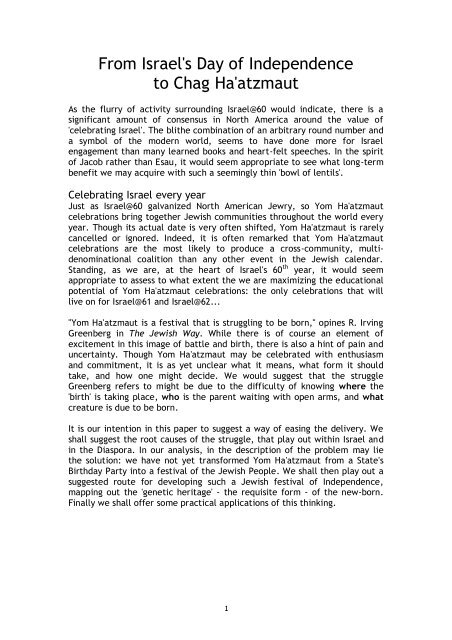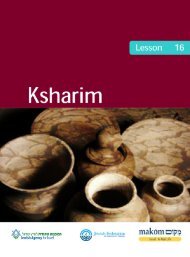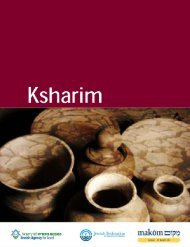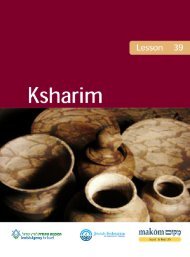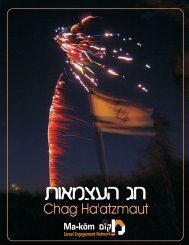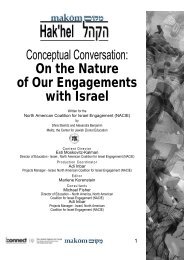printable pdf. - Makom Israel
printable pdf. - Makom Israel
printable pdf. - Makom Israel
Create successful ePaper yourself
Turn your PDF publications into a flip-book with our unique Google optimized e-Paper software.
eing an Irish Catholic event. The largest St Patrick's Day Parade now takesplace in Chicago not Dublin. The slogan throughout the States, "Everyone'sIrish on St Patrick's Day", marks its ecumenical, non-ethnic intentions, as thefestival celebrates more the sale of Irish-style goods (mainly great beer)than the promotion of Irish life and authentic culture. Despite this gradualdraining of the festival's content, St Patrick's Day nevertheless celebrates amore authentic, less complicated sense of exilic longing, than does YomHa'atzmaut for Jews. <strong>Israel</strong> is not 'home' to a Jewish New Yorker in the samesense that Ireland might be 'home' to a fourth generation Irish New Yorker.Perhaps a 'Shtetl Day' might be more attractive in this sense…We might turn to Kwanzaa, a fascinating exercise in ritual creativity, thatwas invented in the late 1960s to celebrate 'African' culture. This is afestival that only exists in the United States, in order to commemorate aculture and a land to which many African Americans in the States have anundefined and indirect connection. Historical or geographical authenticity isnot part of its discourse, and as such its nature is widely variable andconstantly changing. The brainchild of radical Black activist MaulanaKarenga, this festival is now largely a middle-class black event, valued inparticular by those who have escaped the poverty and suffering associatedwith the black experience but who wish nevertheless to celebrate theirethnic identity. Similar to Yom Ha'atzmaut for North American Jews,Kwanzaa acts as a recommitment holiday 4 , attempting to strengthen theethnic identity of the community by celebrating an indirect connection to a'homeland'. But of course Kwanzaa, unlike Yom Ha'atzmaut in <strong>Israel</strong>, doesnot exist in Africa. The name itself is "a product of creative culturalsynthesis" 5 , and the festival's ritual is a conglomeration of harvest festivalsmarked throughout the African continent. By contrast - no diasporaninvention - Yom Ha'Atzmaut arose and is perpetuated first and foremost inorder to mark the ongoing significance of a particular historical andgeographical event.Knottnerus and Loconto have pointed out how this tension between thecelebrators and the celebrated can often develop in the opposite direction.While in Kwanzaa, African-Americans celebrate their 'African heritage' withlittle clear reference to Africa, in Krebs the celebration of 'Italian heritage'takes place with no reference either to Italy, or to the local Italian-Americans themselves! Knottnerus and Loconto describe how the immigrantItalian community in the town of Krebs celebrated their homeland in afestival that was gradually taken out of the hands of the ritual legitimatorsand given over to what they term the ritual entrepreneurs. The ItalianFestival moved town (better parking) and found its ethnic content and4 Amitai Etzioni, We Are What We Celebrate, 20045 "It is a made-up word, from the Swahili phrase matunda ya kwanza, which, according toKarenga, means 'first fruits'; an extra 'a', he writes, 'has become convention', though he doesnot explain precisely why." Anna Day Wilde, "Mainstreaming Kwanzaa", in We are what wecelebrate, ed. Amitai Etzioni 20043
participation gradually diluted. "As the public appeal and overall success ofthe venture has increased, the significance of the event for the members ofthe ethnic group has decreased." 6Given this plethora of examples of similarity yet difference, it is perhaps nogreat surprise that Jewish communities celebrating Yom Ha'atzmaut look to<strong>Israel</strong>. Yet in <strong>Israel</strong> too, we find a festival in flux, and in question.Whose festival is it anyway?Though an outsider might be amazed, popular <strong>Israel</strong>i culture still does notunderstand or accept why Arab <strong>Israel</strong>is do not tend to celebrate YomHa'atzmaut 7 . Though the establishment of the State of <strong>Israel</strong> most certainlyfeatures prominently in the Palestinian national narrative, it would be verydifficult to expect the significance of this event to engender rejoicing andmerriment! As long as the majority in <strong>Israel</strong> are still keen to "gather infamilies and settlements for rejoicing and gladness, for memorial andthanksgiving, for unity and inspiration" 8 , then this day's festivities will neverdraw the majority of <strong>Israel</strong>i Arabs. For entirely different reasons, the ultrareligiousJewish community in <strong>Israel</strong> generally does not mark YomHa'atzmaut, either. Thus even before looking for nuance, we know thatmore than a quarter of <strong>Israel</strong>'s citizens are not touched by the joyous natureof its own Day of Independence.Beyond this, the Orthodox Jewish community is far from unified in itsrelationship to this day. While celebration is by no means frowned upon,there is no consensus about the religious significance of the day. R. OvadiaYosef 9 among others has ruled that Hallel should be recited, but without itsblessing. This ambivalence points to Zionism's key challenge to the orthodoxworld: was the establishment of the Jewish State a human achievement, ora divine one? One internet Rabbi protests the implication of this indecision:"Either Medinat Yisrael isn’t such a great historical event for Am Yisrael, orGod didn’t have a hand in it!" 10 Doubt on either of these issues leads theorthodox world to remain not fully committed to the redemptive nature ofYom Ha'Atzmaut. It is certainly a day for celebration, a day that over-rides6 Strategic Ritualization and Ethnicity, Knottnerus and Loconto in Sociological Spectrum, 23:425-461, 20037 An entire program on Reshet Bet in early December 2007 was given over to the question ofwhy the Arab Members of Knesset were not present at the ceremony marking the UNdecision of 29 th November 1947.8 From the original governmental proclamation of Yom Ha'atzmaut.9 R. Ovadia Yosef. Teshuvot Yabia Omer (Orach Chaim 6:41)10 R. Alex <strong>Israel</strong>.http://www.torahcurrents.org/index.php/article/yom_haatzmaut_and_the_obligation_of_praise/4
the restrictions of the Omer period, but the extent to which one shouldthank God for the creation of the State of <strong>Israel</strong>, will remain in question.As Schweid comments, it would be unrealistic to expect religion to take alead in the shaping of a festival that by its very nature takes place in a nonreligiousrealm. As many other modern scholars do, he compares theestablishment of the State to the festival of Pesach, yet Schweid does so todraw difference and not similarity:בפסח עם ישראל חווה את חירותו כ "עם סגולה", ואילו בחגהעצמאות הוא חווה חירות של עם ככל העמים עם מדיני.11,The very 'normality' of the event, its very universality, Schweid argues,would work against the particularity of the Jewish tradition.Although military parades, a celebration of that which enabled theestablishment of the state and a symbol of the Jewish return to power,were a standard aspect of <strong>Israel</strong>'s Yom Ha'Atzmaut, they are no longer invogue. No doubt to leave Yom Ha'Atzmaut as a secular celebration of theattainment of collective power, would have been to ask for trouble.Eventually either the historical perspective would be lost, thus transmutingmight and those who wield it into a form of militaristic idolatry, or therealization of the cost of wielding collective power might dull any sense ofcelebration. As Schweid pointed out, while joy is a key component to thisfestival, it must somehow arise 'spontaneously' and without prior intention,divine or personal. What happens when a people no longer enjoys itscollective responsibility for military action, poverty, oppression, corruptionand the like? What happens to the party when no one feels like partying?Yom HaZikaron issuesIn the early days of the State, there was Independence Day, but noMemorial Day. Hey B'Iyyar was the holiday both to celebrate the 'birthday' ofthe state, and the day to remember its fallen. As death rates grew, and thepain of such loss became unbearable, it became clear that a country cannotcelebrate its existence on the same day as it mourns the price it has paidfor it. Hence Yom Hazikaron – Memorial Day – was born as a separate dayfrom Yom Ha'atzmaut.But not entirely separate. Even in this separation there is a curious bittersweetmoment as the two days and two contrasting experiences meet whenIndependence Day kisses Memorial Day goodbye at the 'TransitionCeremony'. In contrast to the United States, where Memorial Day standsseparate from Independence Day and originally commemorated a differentwar, Yom HaZikaron is fused with Yom Ha'atzmaut for they are both sides ofthe same coin. The miracle of Yom Ha'Atzmaut, according to Schweid, is a11 "At Pesach, the nation experienced liberation as a "unique nation", whereas ChagHa'atzmaut is experienced as a "nation like any other", as a nation-state." Eliezer Schweid,Sefer Machzor HaZmanim, Am Oved5
man-made miracle 12 , and so the human cost of such a miracle must bemarked as part of the same festival.This fusion of Yom HaZikaron with Yom Ha'Atzmaut enforces threedifficulties: First, it raises sacrifice for one's country as a supreme value andin so doing shadows all other values that might be associated with theestablishment of the State of <strong>Israel</strong>. Second, it will constantly, annually,threaten to overwhelm the "collective effervescence" that the festival wascreated to engender. Third, the fusion of Yom HaZikaron with YomHa'Atzmaut makes it even harder for Diaspora Jewry and <strong>Israel</strong>i Jewry toshare an equivalent emotional attachment to this period.Unfortunately for the Jewish community in North America looking for the'real Yom Ha'Atzmaut', beyond Yom HaZikaron, there are few <strong>Israel</strong>i ritualsand public events that are constant, or replicable. The Bible Quiz, TheTorch lit Procession, and the announcements of the <strong>Israel</strong> Prize are thehonorable exceptions. Fireworks displays are not an <strong>Israel</strong>i invention, norare family barbecues in public areas is not yet a custom that resonates inthe Jewish communal world. As a result, even when the Jewish communitylooks to <strong>Israel</strong> for a lead in the nature of Yom Ha'Atzmaut celebrations, it isliable to attempt to echo an original which is somewhat hollow itself.What's the story?Beyond, or perhaps underlying this lack of deep form to Yom Ha'atzmaut liesthe difficulty in defining the festival's narrative. If we see the form of afestival as a manifestation of a master narrative, then an unclear orunresolved narrative might lead to a form that is confused. ProfessorMichael Rosenak refers to Rotenstreich's two ways of conceptualizing andreading modern Jewish history 13 . The first he characterizes as "The JewishProblem" and the Jewish reaction, and the second as Jewish CulturalDistinctiveness and Ingenuity. The first approach would be to see the historyof the Jewish people in the light of the behavior of the non-Jewish worldtowards us; the second would be to read Jewish history 'internally', lookingto Ahad Ha'am rather than Herzl, for example. These two approaches towhat we might even call 'Narrative style', tends to make our search for aconsensus on Chag Ha'atzmaut's narrative somewhat elusive.For example, during MAKOM's Chag Ha'atzmaut seminars, each participant isasked to note down the seven plot-points to his or her 'Yom Ha'atzmautnarrative'. Point one would be the start of the story, point seven wouldmark its ending. Beyond the fact that so many of the participants' storiesbegin at such varying places: Abraham's promise, Jacob's move to Egypt,destruction of the second Temple, Dreyfus trial, 1948… the most surprising12" "This is a miracle of the renewal of the powers of a weaknation""זהו נס התחדשות כוחותיו של עם חלש13 The Problem of Jewish Peoplehood, Michael Rosenak6
discovery was that at least fifty percent of participants at seminarsthroughout the States and in <strong>Israel</strong> did not place the Holocaust in their storyof Yom Ha'atzmaut. When telling the story, when creating the emotionalcontext 14 for the establishment of the State of <strong>Israel</strong>, over half of theseJewish professionals did not see the Holocaust as having a role to play.Yet for Greenberg and others, the significance of the establishment of theState of <strong>Israel</strong> cannot even begin to be understood without appreciating thehorrors and helplessness of the Holocaust taking place in the same decade.Whether or not divinely inspired or encouraged, the establishment of theState so shortly after the Jewish people's near-complete destruction, tells amythically-proportioned story of redemption from darkness into light. Thisdeep schism in narrative assumptions would seem to arise from thedichotomy described by Rotenstreich, that has yet to be overcome.The very nature of the Zionist revolution was the way in which itsproponents called for a 'return to history'. Understood in Rotenstreich'sterms, we may say that the early Zionists wished to forge the two narrativestreams into one. Indeed this interplay between the external and theinternal, the universal and the Jewish, the historic and the cultural,continues to resonate and rebound throughout the past sixty years of <strong>Israel</strong>'sexistence. Until we find a way to harmonize these two narrativeperspectives, we will find a consensual form to Yom Ha'atzmaut difficult toreach.Celebration of rupture?We might, however, point to a third overlapping narrative that plays outthroughout Jewish life: That of the establishment of the State of <strong>Israel</strong> as arupture. After the establishment of the State, the collective identity of theJewish people was changed beyond recognition. The establishment of theState did not only symbolize a transformation from weakness to power, orfrom destruction to victory; it also engendered a stunning change to thenature of the Jewish people.An entire ethical framework needed (and still needs) to be reworked, nowthat the Jews had returned to power ("Ethical muscles not flexed forcenturies are now used; sometimes they are stiff and sore" Greenberg). Awhole religious code needed (and still needs) to face the far-reachingconsequences of no longer living in exile. At least half the Jewish Peopleneeded (and still needs) to learn what it means to be a majority withcollective responsibility. All these changes are to be celebrated andrejoiced, but they have without doubt presented a huge challenge to aPeople whose entire identity was built on powerless, helpless exile. Whilegrowth is positive, it is also painful and irreversible, as any snake can tellyou.14 REF AND QUOTE EGAN7
Given this narrative of forced growth, this story of positive yet painfultransformation, we find ourselves wondering whether Yom Ha'atzmautneeds to be built more as what Turner calls a 'life-crisis ritual', rather than afestival? If the establishment of the State of <strong>Israel</strong> were to be seen as a riteof passage for the Jewish People, a moment when the nature of the Jew ispermanently and dramatically transformed, then very different energies arerunning beneath this 'festival', that call for a very different form of ritualcommemoration.Since life-crisis rituals emerge in situations of alreadyheightened emotion and energy, the task of ritual is to"provide an organizing set of principles, traditional waysof binding for the moment the opposing forces within thecommunity and tying together the past with the present."Abrahams, cited by Turner 15Of course the establishment of the State of <strong>Israel</strong> took place sixty years ago,and in that sense we might argue that one does not go through a life-crisisritual every year. Yet at the same time we might say that the Jewish Peopleare still in the throes of the growth pains that ensued. The events of 1948are still reverberating through the world, their consequences too close, tooexhilarating, too painful, and too deep to be fully appreciated. This crisis ofpost-<strong>Israel</strong> Jewish identity did not end in 1948, but is ongoing.In order to allow this added narrative weave to our Yom Ha'atzmaut, wemight do well to follow Abrahams' guidelines, and look for a reassuring ritualthat offers "an organizing set of principles", and "traditional ways" oftemporarily holding together opposing views, and uniting past with present.In short, we need to revision Yom Ha'atzmaut as a 'traditional' Jewishfestival, as a Chag.Chag Ha'atzmautIn the "Building Jewish Community through Culture" seminar of July 2003 16 ,Shoshana Pakciarz the then-Executive Director of Boston's New Center forArts and Culture, complained about the Yom Ha’atzmaut celebrations inBoston: "This is the most seminal event in recent Jewish history, and only10,000 people showed up out of 250,000 Jews in the city… 10,000 peoplecoming to a poor shopping experience is dismal." Though many othercommunities would be proud to number their Yom Ha'atzmaut participantsin the thousands, Pakciarz' frustration touches on our larger task: YomHaatzmaut should mark a landmark in Jewish History, and not just in thehistory of a 60 year old state.Inspired by R. Joseph Soloveitchik, R. Irving Greenberg is convinced that thecreation of the State was 'the New Exodus': "The creation of the state wasan act of redemption of biblical stature… The sweep from the degradationof slavery in Egypt to the heights of Sinai and the Promised Land had a15 Celebration, ed. Victor Turner16 Convened by Oranim College and the Jewish Agency's People to People Center.8
shorter arc than the swing from the depths of Auschwitz to the heights ofJerusalem". Indeed the key reference point in the Rabbinic debate overreciting Hallel on Yom Ha'atzmaut is, quite fittingly, the response to themiracle of the Parting of the Red Sea.The time may have come for us to begin draw inspiration not from othernationalisms, nor from other ethnicities, but from our own. We need tobegin to see and develop Yom Ha'atzmaut as a Jewish holiday: a chag.Paradoxically, because Yom Ha'Atzmaut is such an established yet unclaimedfestival in the orthodox world, we may find ourselves with a great deal ofroom for maneuver. We may draw from religious wisdom withoutcommitting to its authority: we may refer to religious constructs withoutcommenting on their essence.Many scholars wiser than us have attempted to draw on Jewish religiousforms and symbols for this day. Yom Tov Lewinski proposed that YomHa'atzmaut take the form of "Shabbat HaMedina": a day of rest, with candleslit Hanukkah style, on the window-sill. Professor Ben Zion Dinur called forcandles, family meals, and a reading of the Declaration of Independence 17 ,and others have produced Haggadot for Yom Ha'atzmaut. It is not ourintention to critique these approaches, but rather to understand theunderlying structure these scholars sought, in order to offer an additionalapproach.Drawing gratefully on Greenberg's exploration of the festivals as "theunbroken master code of Judaism", we can begin to appreciate a basicunderlying structure to our chagim, that can be usefully applied to YomHa'atzmaut. Learning from Greenberg, and the in-depth research andanalysis of Esti Kalman-Moskovitz 18 , we can determine a framework thatmost chagim are 'built' on. Each chag has a narrative and a theme thatexpress themselves through a designated experience, structuredreflection, and symbolic action 19 . Having already discussed the complexnature of interweaved and contradictory narratives, we shall now address apossible theme for Yom Ha'atzmaut, or what Abrahams terms "an organizingset of principles".The organizing theme of Yom Ha'atzmautThere are thousands of details and practices associatedwith each Jewish festival. Though customs have grownand changed over millennia, and each community andevery age has added its own special flavor and detail,17 Both scholars cited in Greenberg's The Jewish Way18 Esti Kalman-Moskovitz, ושמחת בחגך – working source document utilized in numerousseminars across North America in 2007.19 For more in-depth analysis of this structure, please also refer to the working document ChagHa'atzmaut by Gringras and Moskovitz, 2007.9
Each holiday has one central metaphor thatorchestrates myriad details into one coherent whole.(Greenberg)Faced with a festival whose narrative meaning is still being contested andlived through, what kind of metaphor might we find? Is there a way toevocatively and succinctly summarize and focus at least three sometimescontrastingnarratives? Greenberg's task is perhaps beyond us. It may be thata single "central metaphor" is too much to ask. (In our defense we might alsoask whether there is a consensus on the central metaphor of Purim, forexample?) Instead we should aim for an organizing theme. A set ofprinciples to give shape and depth to this annual celebration.In other words, what should Yom Ha'atzmaut be 'about'? It is clear that"<strong>Israel</strong>'s Independence Day" is insufficient. This standard secular 'like anyother nation' approach ignores the extreme nature of the Jewish People'slack of independence prior to 1948, and does not sufficiently address theconnection between this event and the rest of the Jewish world. "Theemergence of the Jews from powerlessness" (Greenberg) would certainlytouch on an aspect of the creation of the State, but could equally refer toJewish political power in USA. It makes no reference to the specific placecalled <strong>Israel</strong>. "The significance of the establishment of Jewish Sovereignty ina place of ultimate importance to the Jewish People" would not be far off,but is thoroughly uninspiring. We need a theme that is intellectuallyengaging, broad enough to address all possible narratives of ChagHa'atzmaut, and resonant enough to inspire the imagination.We would suggest that Yom Ha'atzmaut should mark the following theme:– To be a free people in our land להיות עם חופשי בארצנוThis would allow us to focus on the four areas of Zionism that togetherwould suggest a unique aspect to Jewish existence.– To be – would address the way in which the creation of the State of להיות<strong>Israel</strong> served and serves the survival or the Jewish people. To be in thesense of 'exist'. It would likewise explore the idea of 'normality' that <strong>Israel</strong>was expected to engender. To be in the sense of 'let it be'…– People – would address the way in which <strong>Israel</strong> is connected to the עםJewish People culturally, historically, religiously. Where <strong>Israel</strong> expresses itsconnection to the Jewish world and its meaning. At the same time this subthemewould address the nature of Jewish collectivity.– Free – would address the nature of freedom as embodied in the חופשיcreation of the State. Not simply the freedom of Pesach, which celebrates afreedom from suffering and persecution, but also the very particular form offreedom that Statehood has brought: the freedom to take responsibility foroneself, the freedom to grant or refuse freedoms to others. Freedom wouldalso refer to the freedom to create, to innovate, and to renew.10
– In our land – would address the specificity of <strong>Israel</strong> as a בארצנוgeographical, political, and historical entity with deep significance to theJewish People. This sub-theme would also address the question ofownership: the proof of ownership and the expectations and responsibilityof 'owners'.Were we to remove the word People – עם – from this phrase, we would beleft with what was the Meretz slogan in favor of the Gay Pride March inJerusalem 2006. To be free in our land is a worthy aspiration that pays noheed to a shared Jewish collective. Were we to remove the word Free –– we might sum up the cultural non-military approach of R. Yochanan חופשיben Zachai, establishing Roman protection of Yavneh's scholars. Andremoval of In Our Land – בארצנו – would leave our Chag Ha'atzmaut themewith no reference to <strong>Israel</strong>!To our mind, the other advantage of this four-point organizing theme, isthat it can give respect to unresolved questions and concerns. To whatextent <strong>Israel</strong> has ensured the continued survival of the Jewish People,(עם) how far <strong>Israel</strong> has strayed from or developed its culture ,(להיות)whether <strong>Israel</strong>is take full responsibility for their collective and individualactions ,(חופשי) and a Diaspora Jew's connection to the land (בארצנו) – allthese are issues that can be aired and housed within this overall structure.In this way we bind "for the moment the opposing forces within thecommunity". Approaching this framework from the narrative of rupture, orpainful growth, we manage to draw our concerns for <strong>Israel</strong> into a higher anddeeper realm of consideration, so that the rupture aspect of the <strong>Israel</strong>narrative need not be suffered or ignored, but honored.This four-point set of principles can also offer us an effective pathway intorejoicing. For no matter how one chooses to define our current situation,the Jewish People is closer to normality and more equipped to survive andfend for itself than it was before 1948 ,(להיות) is more capable of acting asa collective ,(עם) more free than ever in history ,(חופשי) and living in theland of our forefathers .(בארצנו) Looking at Chag Ha'atzmaut through theseprinciples, we can find reason for joy as well as reflection.Designated ExperienceAs Schweid has pointed out, unlike other chagim, there is no commandmentfor the participants to enjoy themselves at CH. While we bow our headswith a smile before the stern Sukkot order " " – "And you shall behappy in your festival", there is no God-given instruction for the experienceof Yom Ha'atzmaut. This is, however, only half the story. The orthodox Jewnevertheless does not recite any prayers of contrition, and suspends thestrictures of the Omer for this day. No one has ever thought that YomHa'atzmaut should be anything other than a party: emotionally it is almostseen as the positive to Yom HaZikaron's negative.ושמחת בחגך11
According to Schweid there are two ways to ensure a festive "collectiveeffervescence". One way is, as he says, to make sure that participants comearmed with a divine conviction to rejoice. Given that this is not apparent forYom Ha'atzmaut, the other choice is for the State to 'make them happy' 20 ."Festivals… must initiate their own energies." (Abrahams) The onus forrejoicing falls on the official organization, and not upon the participantsthemselves. They are 'to be aroused' into joy and merriment, rather than toarrive 'in a good mood'. 21 This approach would suggest that the success of aYom Ha'atzmaut celebration will stand or fall on the budget set aside for thefireworks display.We would suggest that there is a third way, that the joy can emerge notonly through the predisposition of the participants, and not only thanks tospectacular pageantry, but also through the power of a dramatic orintellectual design.One way of applying this approach would be to adopt a narrative of YomHa'atzmaut that is already reflected in the three ritual days of this period.R. Avram Infeld argues that Yom Ha'atzmaut concludes a process ofcollective awareness that begins at Yom HaShoah. For him the collectivedrama of the redemption of the Jewish People lasts nine days, taking in YomHaZikaron, and ending with an celebration of life at Yom Ha'atzmaut. In thisinstance, the 'happy-ending' of the drama explodes out of the pain and lossthat precedes it.Another application might be to address the more reflective aspects ofrupture, before reaching the more effervescent aspects of success. It maywell be that once the life-crisis aspects of the establishment of the State of<strong>Israel</strong> have been aired and given form, the 'demons' will have been banishedfrom the hearts of the participants and spontaneous rejoicing might beeasier. In this sense Yom HaZikaron serves an entirely different purpose. Asa day of mourning, and a day for giving honor to the fallen, Yom HaZikarondoes not offer any constructive outlet for questioning the nature of theZionist idea.[Needs more work…] [and examples…] [and more on dramatic structures andtheir application…]Structured ReflectionAs Van Gennep originally pointed out 22 , life-crisis transitions or "passages"can be dangerous and tend to be mediated by rites. In "binding for themoment the opposing forces within the community and tying together the20""אין זו "שמחת מצווה" ואין זו מצות שמחה שכל יחיד מתחייב בהמוסדות השלטון משמחים את העם...21 It has become customary to add on to party invitations the injunction: "come in a really"תבוא עם המון מצב רוח !" mood!" good22 The Rites of Passage, Arnold Van Gennep, 196012
past with the present" (Abrahams), these rites can provide stability andreassurance to the bewildered or concerned, and can give form andlegitimacy to disagreement within the community.Indeed a very carefully structured form of reflection is built into most of ourchagim. It has been written that the three foot-festivals, Pesach, Shavuot,and Sukkot, are accompanied by a very specific kind of megillah. Pesach,the festival celebrating the power of God's outstretched hand, power thatdid not stop even at the killing of innocent Egyptian children, isaccompanied by Shir HaShirim – Song of Songs. Lest we forget that whilepower is necessary, so too is compassion and love. On Shavuot, when theLaw was given to our people, the Book of Ruth is read. This megillah, placedin the context of overarching Law, celebrates characters – Ruth, Boaz – whogo beyond the law, raising up its spirit. And as we enter our Sukkah,celebrating the lightness of being, commanded to be happy, we readKohelet – Ecclesiastes – the ultimate text of weight, disappointment, andtired realism.Each megillah acts as a commentary on the festival itself. These megillotaddress the central message of the festival and suggest not its opposite, buta deliberate balancing factor, presenting a parallel value that tempers thatof the festival's itself. For Chag Ha'atzmaut it might be tempting to reachfor the Declaration of Independence, or for one's Tanach, to find thespecific megillah appropriate to our Chag Ha'atzmaut. But before doing so itwould be useful to increase the breadth of our options. Perhaps a piece ofliterature from beyond the Tanach might be equally appropriate? Whatmight the story of the Golem of Prague reflect on <strong>Israel</strong>'s narrative ofsovereignty, power, and tradition? How could a biography of Albert Einstein– an individual, Diaspora-dwelling, light unto the nations, almost-Presidentof <strong>Israel</strong> – comment on Am Chofshi b'Artzenu? Must we choose only one text?And if literature, then why not any other art form? Perhaps our guidingcriteria for programming <strong>Israel</strong>i arts events for Chag Ha'atzmaut should be:Each event should act as a potential megillah that casts the reflective lightof commentary upon our central metaphor.In the meantime MAKOM is creating a Chevruta booklet, similar to thosecreated annually by Limmud Conference UK, that will be comprised of textsלהיות עם חופשי and questions arranged according to the principles ofOur suggestion to communities and organizations will be to make .בארצנוuse of these booklets in a mass-chevruta event, that will contain within itthe energies and excitement of collective learning. In this way the airing ofquestions can be enjoyable and even cathartic for the community. It mightbe that this chevruta session ought to immediately precede the fireworksand music party…?Symbolic ActionAs we have stated, there may be value in drawing on Jewish 'traditionalforms' of ritual so as to lend - not necessarily authority - but contextual13
familiarity to our Chag Ha'atzmaut rites of passage. One such form might bethe Seder Plate, as applied to the four principles of Chag Ha'atzmaut. AtMAKOM we have so far thought that one might raise and drink a glass ofwater to mark the life-giving simplicity of ,להיות to cut open a pomegranateto mark the unified and diverse nature of ,עם to eat a wild sabra fruit tomark the prickly yet sweet ambivalence of ,חופשי and to light a vial of olive.ארצנו oil to markComing to the final deadline for sending off this piece, I would say that theunderlying drive of this work is to suggest that any artistic performance,pageant, or celebration must first establish a shared context, a sharedphilosophy among its participants, before starting to think about its mostresonant or powerful form. Call it 'exposition', or 'setting the scene', thesuccessful play will do this as part of the ongoing action, pulling theaudience into a commitment to the characters' needs and restrictions intheir particular environment. In order for Chag Ha'atzmaut to bringparticipants in the Diaspora and <strong>Israel</strong> to a collective effervescence, it mustclarify the way in which its narrative speaks to the commonality of all, andensure that this commonality is persuasively laid out for all - before thechampagne corks are popped.Dec 2007Robbie GringrasArtist-in-ResidenceMAKOM <strong>Israel</strong> Engagement Network14


